Few culinary experiences can rival the satisfaction of savoring a perfectly cooked steak. In this comprehensive guide, we’ll take you through the art and science of cooking steak to perfection. Whether you’re a seasoned chef or a novice in the kitchen, you’ll find valuable tips, techniques, and answers to your burning questions about steak preparation.
The Basics
Understanding Steak Cuts
Before we dive into the cooking methods and techniques, let’s start with the foundation — the choice of the right steak cut. The flavor, tenderness, and overall dining experience hinge on this crucial decision. Here are some of the best cuts of meat to consider:
Ribeye: Known for its marbling, a ribeye steak is rich, flavorful, and tender.

Filet Mignon: As one of the most tender cuts, the filet mignon is prized for its buttery texture.

New York Strip: This well-marbled cut offers a perfect balance of flavor and tenderness.
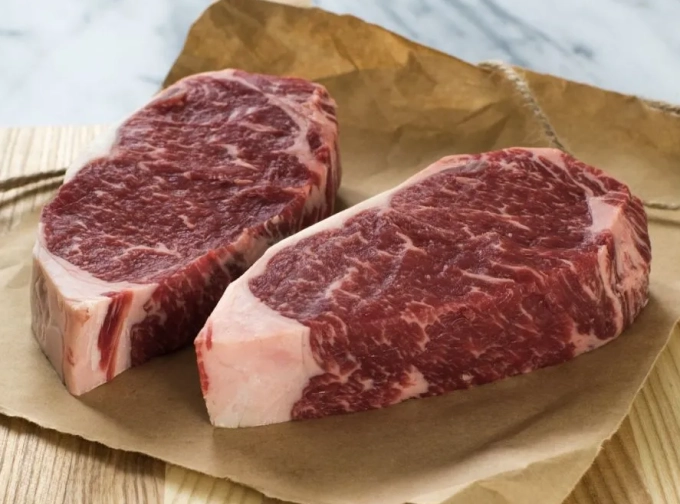
T-Bone: Combining the tenderness of filet mignon and the bold flavor of the strip, the T-bone is a classic choice.

Desired Doneness
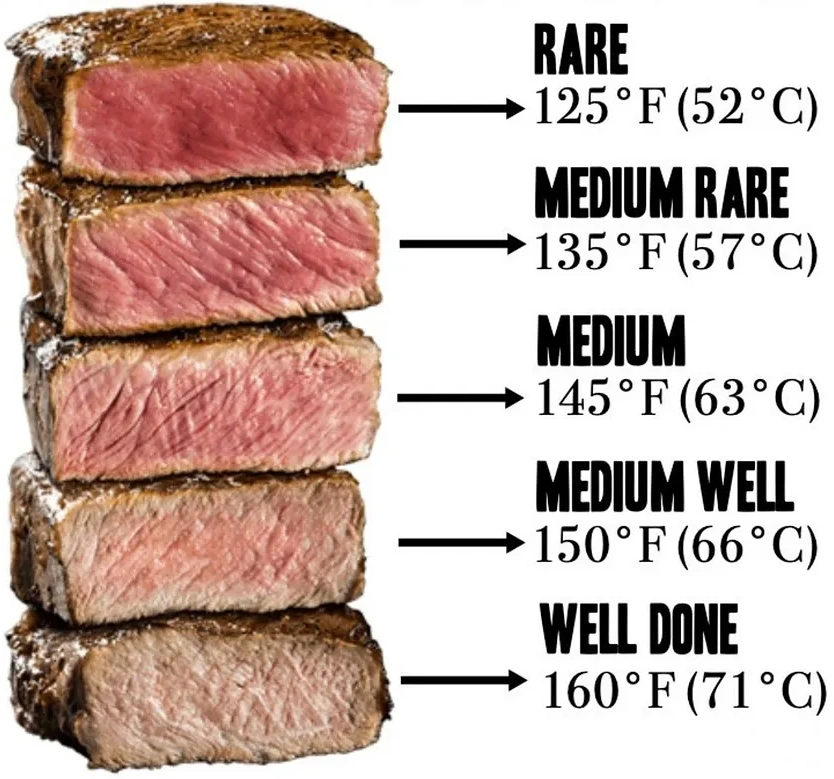
In steak, doneness is a pivotal factor defining its flavor, texture, and juiciness. Everybody has a preference, starting with “Blue Steak,” which is the least cooked level. It is often just seared on the outside, with the inside remaining almost entirely red and at room temperature, offering a very soft texture. A “Rare Steak” is cooked slightly longer, mostly red in the center, with warmth and a more tender and moist texture. Moving “Medium Rare Steak,” a favorite among steak connoisseurs, features a warm, red center that’s more cooked than rare, providing a balance of tenderness and flavor. “Medium Well Steak” is a step further, with a hint of pink at its core, firmer to the touch, and less juicy than its lesser-cooked counterparts. Finally, a “Well Done Steak” is cooked thoroughly, with no sign of pink. It’s the firmest of all the levels and often less juicy, yet still can be flavorful when cooked skillfully. Each level of doneness caters to different preferences, balancing the steak’s natural flavors with texture and juiciness.
Blue: 110–115° F

Cooking a blue steak, known for its minimal cooking and fantastic red center, requires precision and speed. Start by selecting a high-quality, thick-cut steak to ensure even cooking. Bring the steak to room temperature for about 20 to 30 minutes before cooking; this promotes even cooking and better texture. Heat a skillet or grill to a high temperature — the surface should be smoking hot. This high heat is crucial for creating a quick sear while keeping the steak’s interior cooked to the standard. Season the steak generously with salt and pepper before placing it in the pan. Sear the steak for about one minute on each side, just enough to brown the exterior while leaving the inside mostly raw. The goal is to create a slight crust on the outside while maintaining a blue steak’s extraordinary red interior characteristic. Once seared, let the steak rest for a few minutes before serving. This step is essential for any steak, as it allows the juices to redistribute throughout the meat. Remember, blue steak is for those who enjoy steak as rare as possible, so it’s not recommended for everyone, primarily due to food safety concerns with undercooked meat.
Rare: 125° F

Cooking a rare steak, which is slightly more cooked than a blue steak, involves a delicate balance of heat and timing to achieve its signature warm, red center and tender texture. Start by choosing a good quality, preferably thick-cut steak, and let it come to room temperature for about 20 to 30 minutes before cooking. This step ensures more even cooking. Preheat your skillet or grill to a high temperature — it should be hot enough to sizzle and sear the steak on contact. Season the steak generously with salt and pepper right before cooking. Place the steak on the hot surface and cook it on each side for approximately 2 to 3 minutes. This duration creates a browned, flavorful crust while keeping most of the steak’s interior a deep red. The cooking time may vary depending on the steak’s thickness and the heat source. After searing both sides, remove the steak from the heat and let it rest for a few minutes. Resting allows the juices to redistribute throughout the steak, ensuring that each bite is moist and flavorful. Remember, the interior of a rare steak is primarily red and slightly warm, and it should feel soft with slight resistance when pressed. As with undercooked meat, be aware of potential food safety risks when serving rare steak.
Medium Rare: 130–135° F
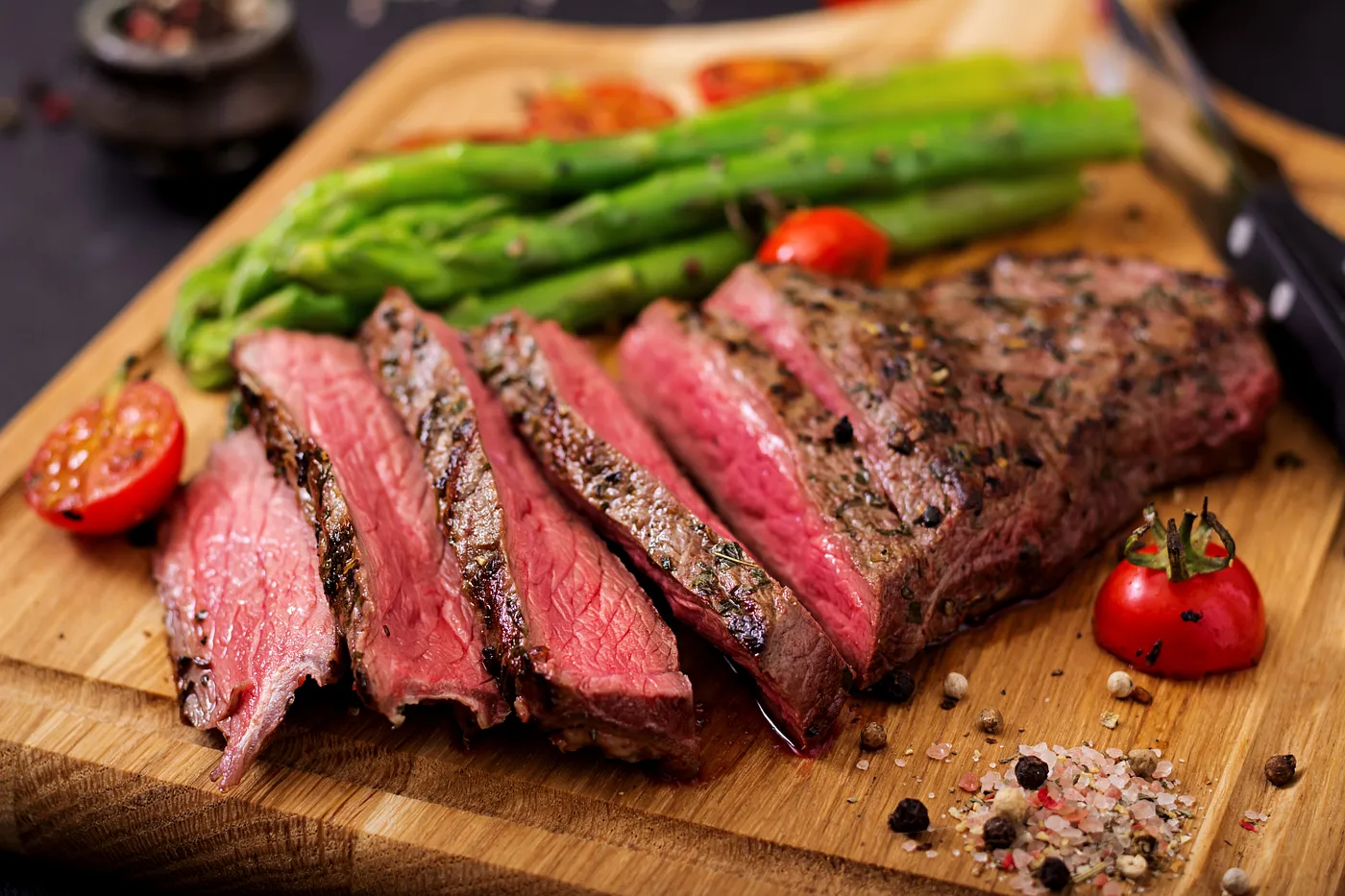
Cooking a medium-rare steak, a preferred choice for many due to its ideal balance of flavor and tenderness requires careful attention to temperature and timing. Begin by selecting a quality steak, preferably about an inch thick, and allow it to reach room temperature for 20 to 30 minutes before cooking. This step ensures more even cooking throughout the steak. Heat your skillet, griddle, or grill to a high temperature so it’s hot enough to sear the steak effectively. Season the steak generously with salt and pepper before cooking for a flavorful crust. Place the steak on the hot surface, cooking it for approximately 3 to 4 minutes on each side, depending on its thickness. This timing is vital to achieving a medium rare steak’s characteristic warm, pink center. The steak should have a browned, slightly charred exterior while the inside remains pink and friendly, offering a tender, juicy texture. After searing, remove the steak from the heat and let it rest for a few minutes. Resting is crucial as it allows the juices to redistribute, ensuring each bite is succulent and flavorful. An adequately cooked medium rare steak should feel firm yet springy and delight steak lovers who cherish a tender, juicy interior with a richly seared exterior.
Medium: 135–140° F

Cooking a medium steak, which balances tenderness and firmness, involves carefully monitoring cooking time and temperature. Begin by selecting a good-quality steak, preferably around an inch in thickness, and let it sit at room temperature for 20 to 30 minutes. This step ensures more uniform cooking. Preheat your skillet, griddle, or grill to a high temperature — it should be hot enough to sizzle upon contact with the steak. Season the steak well with salt and pepper before cooking to enhance flavor and create a delicious crust. Place the steak on the heat, cooking it for approximately 4 to 5 minutes on each side, depending on its thickness. The goal is to achieve a rich, browned exterior while cooking the interior to a pinkish-brown color, with more firmness than medium rare. After cooking, it’s crucial to let the steak rest for a few minutes. This resting period allows the juices to be redistributed, ensuring every slice is moist and flavorful. The texture of a medium steak is firmer to the touch than medium rare, yet it should still retain some juiciness and tenderness. A medium steak offers a well-balanced experience for those who prefer it neither rare nor well-done.
Medium Well: 140–150° F

Cooking a medium-well steak, which is slightly pink in the center and firmer to the touch, requires more time on the heat than its less-cooked counterparts. Start by selecting a high-quality steak, ideally about an inch thick, and let it come to room temperature for around 20 to 30 minutes. This step is crucial for even cooking. Preheat your skillet, grill, or griddle to a high temperature, ensuring it’s hot enough to sear the steak effectively. Season the steak generously with salt and pepper before you place it on the heat. Cook the steak for 5 to 7 minutes on each side, depending on its thickness. This longer cooking time allows the heat to penetrate more deeply, cooking the steak through while leaving a slight hint of pink in the center. Remove the steak from the heat after achieving a prosperous, browned exterior and ensuring the interior is co with a bit of pink. Let it rest for several minutes before serving. This resting period allows the juices to redistribute, resulting in a moist and flavorful steak despite its firmer texture. A medium-well steak is ideal for those who prefer it cooked through but want to enjoy a touch of tenderness and juiciness.
Well Done: 155° F

Cooking a well-done steak, which requires thorough cooking while still maintaining juiciness and flavor, demands careful attention to heat management and timing. Begin by choosing a high-quality steak, ideally around an inch or thicker, to prevent it from drying out. Let the steak sit at room temperature for about 20 to 30 minutes before cooking to ensure more even cooking throughout. Heat your skillet, grill, or griddle to a medium-high temperature rather than high to avoid burning the outside before the inside cooks through. Season the steak generously with salt and pepper before it is heated. Cook the steak for about 6 to 8 minutes on each side, depending on the thickness, flipping it occasionally. The goal is to cook the steak evenly to a brownish-grey color without any pink left in the center while achieving a well-seared exterior. A lower and slower approach is vital to keeping the steak from becoming too rigid or dry. After cooking, let the steak rest for several minutes before serving. This rest period allows the steak to become as juicy as possible. A well-done steak is firm and requires precise cooking to retain moisture and flavor, catering to those who prefer a tougher steak.
Now, after exploring the various degrees of steak doneness — from the barely cooked, cool-centered blue steak to the thoroughly cooked, browned, well-done steak. You’re now equipped with the knowledge to master the art of steak preparation. Each level, be it the lightly seared rare steak with its tender texture, the famous medium rare with its perfect balance of juiciness and flavor, the firmer and slightly pink medium steak, or the more thoroughly cooked medium-well steak, offers a unique culinary experience. The choice of how to cook your steak ultimately boils down to personal preference, influenced by factors like texture, juiciness, and flavor intensity. Whether you prefer the intensely beefy flavor of a rarer steak or the firmer, more cooked texture of a well-done steak, the key is understanding the cooking techniques and times required for each level of doneness. Now that you’re familiar with the spectrum of steak cooking options, you can experiment and find the style that perfectly suits your palate.
The Three Ways to Cook Steak
First of all any method starts with seasoning. Seasoning for steaks should be simple — use only Salt and Pepper. Don’t be shy with your seasonings, your steak should be well covered to have that maximum flavor when it’s been fully cooked. Whether you are grilling, Pan searing, or using a sous-vide prior to cooking your steak should look like this:
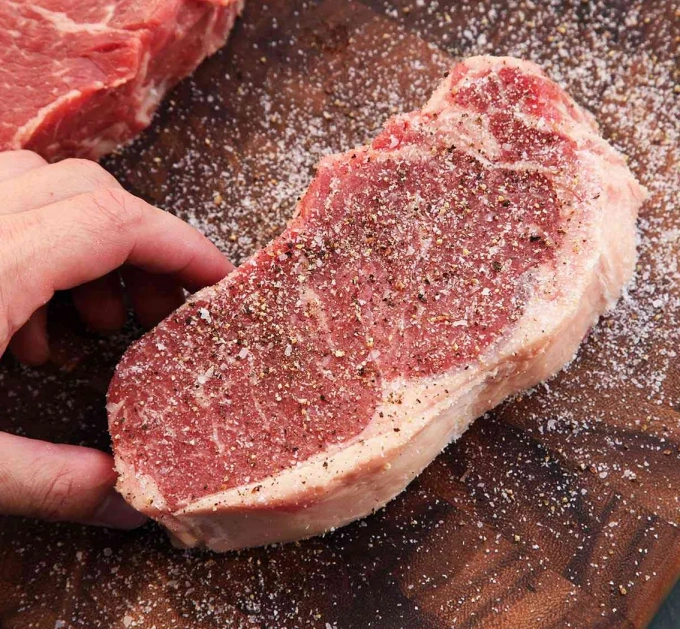
There are three primary methods to cook steak, each offering a unique set of advantages. Let’s explore these methods:
Grilling: Grilling is a beloved technique for its ability to impart smoky flavors and beautiful grill marks. You can achieve different levels of doneness by adjusting heat and cooking time.
Pan-Searing: Often favored by culinary experts like Gordon Ramsay, pan-searing allows for precise control. High heat and butter-basting create a mouthwatering crust. However, for good pan searing, you need the right pan. The best pans are considered Cast Iron and HexClad.
Sous Vide: This is a modern cooking style technique also known as precise and slow-cooking, that ensures your steak is cooked to the exact doneness you desire.
1. Grilling a Perfect Steak (American Style):
Grilling is a beloved technique known for imparting smoky flavors and those beautiful grill marks that make your steak not only taste incredible but look like a work of culinary art. Here’s how to master grilling:
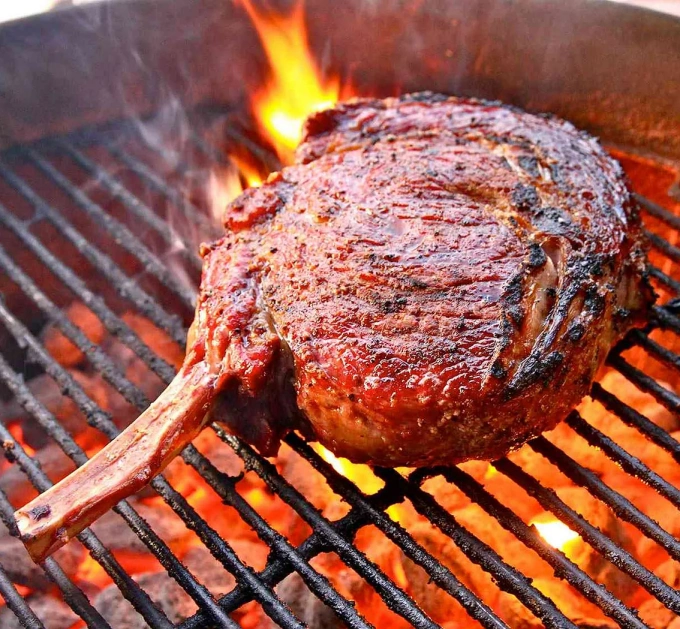
- Preparation: Start by seasoning your steak with salt and pepper. Let it sit at room temperature for about 30 minutes before grilling. This helps it cook more evenly.
- Heat Control: When grilling, you have control over the heat level. For a medium steak, preheat your grill to medium-high heat (around 400–450°F or 204–232°C).
- Cooking Time: Place your seasoned steak on the grill and cook for about 4–5 minutes per side for medium doneness. You can adjust the time for your preferred level of doneness.
- Flipping: To achieve those coveted grill marks, flip your steak only once. Avoid pressing down on it with a spatula; this releases juices and can make your steak less juicy.
2. Pan-Searing (Gordon Ramsay Style):
Pan-searing is a technique favored by culinary experts like Gordon Ramsay for its precision and the mouthwatering crust it creates. Here’s how to perfect pan-searing:
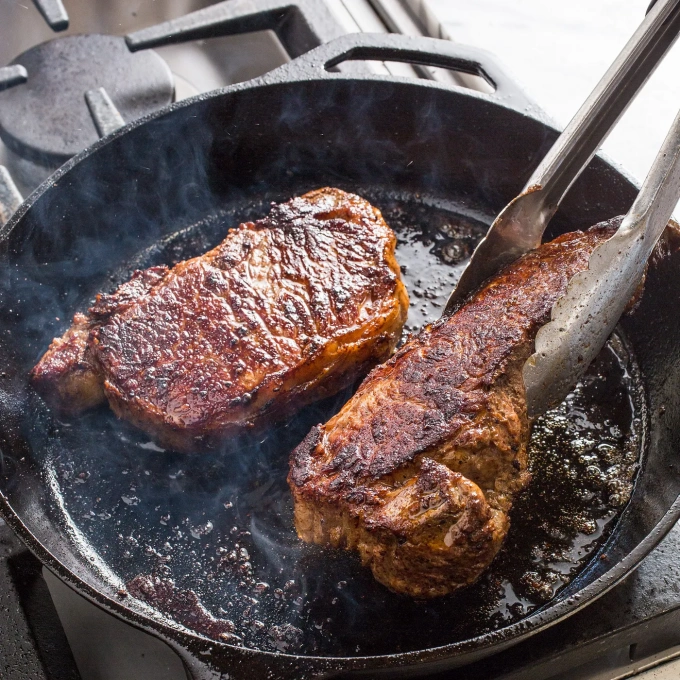
- Preparation: Season your steak generously with salt and pepper. Optionally, you can add aromatics like rosemary or thyme for extra flavor.
- Choosing the Right Pan: The key to good pan searing is having the right pan. Cast ironand HexClad pans are among the best choices due to their excellent heat retention.
- High Heat: Preheat your pan over high heat until it starts smoking. Add a touch of oil or butter to prevent sticking.
- Butter-Basting: Once your steak is in the pan, continuously baste it with foaming butter for extra flavor and a gorgeous crust. This process takes about 1–2 minutes per side for medium doneness.
- Resting: As with any cooking method, let your steak rest for a few minutes after cooking. This allows the juices to be redistributed, resulting in a juicy steak.
3. Sous Vide (Modern Style):
Sous vide is a precise and slow-cooking technique that ensures your steak is cooked to the exact doneness you desire. First things first, for a sous vide method you will need special equipment, you can fin everything you may need in this Sous Vide Kit. Here’s how to use sous vide:

- Seasoning and Vacuum-Sealing: Season your steak and vacuum-sealit in a bag. Set your sous-vide water bath to the desired temperature for medium (135°F or 57°C).
- Cooking Time: Place the sealed steak in the water bath container, fix it with the special metal fences,and let it cook for your preferred duration, usually between 1–4 hours. This slow-cooking method guarantees consistent results.
- Finishing with a Sear: After sous-vide cooking, you can give your steak a final sear in a hot pan or on a grill for about 30 seconds per side to create a delicious crust.
Now, with these detailed instructions, you can choose the cooking technique that suits your preferences and create a perfect medium steak every time. Whether you opt for the smoky allure of grilling, the precision of pan-searing, or the consistency of sous vide, your steak will be a culinary masterpiece.
